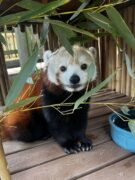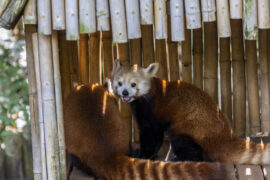Red Panda
Red Panda
Red pandas are classified in their own family, Ailuridae, and are distantly related to raccoons. Unlike their name suggests, they are not related to giant pandas, which are bears. These able climbers live at moderately high elevations, where they forage widely for bamboo shoots, and various fruits.
Ailurus fulgens
Omnivore
Southeastern Asia [VIEW MAP]
Forests
Rose enjoys the higher vantage points of her habitat. If you don’t see her in the upper hut or lounging on the front log, look in the tree to see if she is climbing or sleeping among the branches.
Red pandas are well-adapted for cold weather. On hot days, look for the red panda in the climate-controlled shelter in her habitat.
Photos and Videos
Red pandas are approximately 22–25 inches long, with long, furry tails that are around 15 to 19 inches long. An outer coat of coarse guard hairs overlays and protects a dense, wooly undercoat. Similar to giant pandas, red pandas have a pseudothumb, or “false thumb,” to help manipulate bamboo. While this appendage looks like a sixth digit, it actually is an enlarged wrist bone that functions almost like a thumb, aiding them in holding bamboo while eating.
In the wild, red pandas appear to live about 8 to 10 years, while individuals in zoological settings may live into their late teens. The young attain their adult size by 12 months and become sexually mature at 18 months.
Red pandas breed in the winter – from January through March in the Northern Hemisphere and June through August in the Southern Hemisphere. Both males and females may mate with more than one partner in a season. Gestation period ranges from 90 to 150 days; the average is 134 days. The young, which are born blind and fully furred, open their eyes after 18 days, and remain in the mother’s nest for 90 days. They may stay with their mother until a new litter is born.
Rose enjoys the higher vantage points of her habitat. If you don’t see her in the upper hut or lounging on the front log, look in the tree to see if she is climbing or sleeping among the branches.
Red pandas are well-adapted for cold weather. On hot days, look for the red panda in the climate-controlled shelter in her habitat.
There are two subspecies of red pandas. The Himalayan subspecies, which Rose represents, is native to Nepal, Bhutan, and parts of India, while the second subspecies is native to China.
Red pandas live in temperate climates in deciduous and coniferous montane forests, generally with a bamboo understory. The presence of water and shelter such as hollow logs are important components of their preferred habitats.
Red pandas are omnivores, with bamboo and fruits comprising the bulk of their diet. At the Zoo, we offer bamboo shoots and leaves, fruits such as apples, and nutritionally balanced biscuits.
Red pandas like to climb and explore their environment. We provide a variety of climbing structures, novel objects to explore and manipulate, and pieces of fruit hidden away inside boxes or tubes.





